
КАТЕГОРИИ:
Архитектура-(3434)Астрономия-(809)Биология-(7483)Биотехнологии-(1457)Военное дело-(14632)Высокие технологии-(1363)География-(913)Геология-(1438)Государство-(451)Демография-(1065)Дом-(47672)Журналистика и СМИ-(912)Изобретательство-(14524)Иностранные языки-(4268)Информатика-(17799)Искусство-(1338)История-(13644)Компьютеры-(11121)Косметика-(55)Кулинария-(373)Культура-(8427)Лингвистика-(374)Литература-(1642)Маркетинг-(23702)Математика-(16968)Машиностроение-(1700)Медицина-(12668)Менеджмент-(24684)Механика-(15423)Науковедение-(506)Образование-(11852)Охрана труда-(3308)Педагогика-(5571)Полиграфия-(1312)Политика-(7869)Право-(5454)Приборостроение-(1369)Программирование-(2801)Производство-(97182)Промышленность-(8706)Психология-(18388)Религия-(3217)Связь-(10668)Сельское хозяйство-(299)Социология-(6455)Спорт-(42831)Строительство-(4793)Торговля-(5050)Транспорт-(2929)Туризм-(1568)Физика-(3942)Философия-(17015)Финансы-(26596)Химия-(22929)Экология-(12095)Экономика-(9961)Электроника-(8441)Электротехника-(4623)Энергетика-(12629)Юриспруденция-(1492)Ядерная техника-(1748)
Key information section 1. The Internet is a global network
|
|
|
|

| 
| 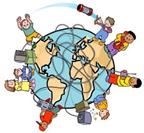
|
The Internet is a global network of interconnected computers, enabling users to share information along multiple channels. Typically, a computer that connects to the Internet can access information from a vast array of available servers and other computers by moving information from them to the computer's local memory. The same connection allows that computer to send information to servers on the network; that information is in turn accessed and potentially modified by a variety of other interconnected computers. A majority of widely accessible information on the Internet consists of inter-linked hypertext documents and other resources of the World Wide Web (WWW). Computer users typically send and receive information with web browsers; other software for users' interface with computer networks includes specialized programs for electronic mail, online chat, file transfer and file sharing. To do it they need to use the same language or protocol: TCP / IP (Transmission Control Protocol / Internet Protocol) and every computer is given an address or IP number. This number is a way to identify the computer on the Internet.
To use the Internet you basically need a computer, the right connection software and a modem to connect your computer to a telephone line and then access your ISP (Internet Service Provider). The modem (modulator-demodulator) converts the digital signals stored in the computer into analogue signals that can be transmitted over telephone lines. There are two basic types: external with a cable that is plugged into the computer via a USB port, and internal, an expansion card inside the computer. A PC card modem is a different, more versatile option for laptops and mobile phones.
At first most computers used a dial-up telephone connection that worked through the standard telephone line. Now a broadband connection, a high data transmission rate Internet connection, has become more popular: either ADSL (Asymmetric Digital Subscriber Line), which allows you to use the same telephone line for voice and fast access to the Internet, or cable, offered by most TV cable providers.

The basic equipment has changed drastically. You no longer need a computer to use the Internet. Web TV provides email and access to the Web via a normal TV set plus a high- speed modem. More recently, 3Generation mobile phones and PDAs also allow you to go online with wireless connections, without cables.
Telephone lines are not essential either. Satellites orbiting the earth enable your computer to send and receive Internet files. Finally, the power-line Internet, still under development, provides access via a power plug.
 The terms Internet and World Wide Web are often used in every-day speech without much distinction. However, the Internet and the World Wide Web are not one and the same. The Internet is a global data communications system. It is a hardware and software infrastructure that provides connectivity between computers. In contrast, the Web is one of the services communicated via the Internet. It is a collection of interconnected documents and other resources, linked by hyperlinks and URLs.
The terms Internet and World Wide Web are often used in every-day speech without much distinction. However, the Internet and the World Wide Web are not one and the same. The Internet is a global data communications system. It is a hardware and software infrastructure that provides connectivity between computers. In contrast, the Web is one of the services communicated via the Internet. It is a collection of interconnected documents and other resources, linked by hyperlinks and URLs.
The Internet consists of many systems that offer different facilities to users.
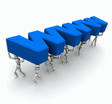 WWW, the World Wide Web, a collection of files or pages containing links to other documents on the Net. It's by far the most popular system. Most Internet services are now integrated on the Web.
WWW, the World Wide Web, a collection of files or pages containing links to other documents on the Net. It's by far the most popular system. Most Internet services are now integrated on the Web.
Email, or electronic mail, for the exchange of messages and attached files is widely used for communication all over the world.
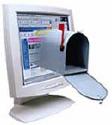 Mailing lists (or listservs) are collections of names and addresses used by an individual or an organization to send material to multiple recipients. The term is often extended to include the people subscribed to such a list, so the group of subscribers is referred to as "the mailing list", or simply "the list". At least two types of mailing lists can be defined: an announcement list is closer to the original sense, where a "mailing list" of people was used as a recipient for newsletters, periodicals or advertising. Traditionally this was done through the postal system, but with the rise of email, the electronic mailing list became popular. The second type allows members to post their own items which are broadcast to all of the other mailing list members. This second category is usually known as a discussion list.
Mailing lists (or listservs) are collections of names and addresses used by an individual or an organization to send material to multiple recipients. The term is often extended to include the people subscribed to such a list, so the group of subscribers is referred to as "the mailing list", or simply "the list". At least two types of mailing lists can be defined: an announcement list is closer to the original sense, where a "mailing list" of people was used as a recipient for newsletters, periodicals or advertising. Traditionally this was done through the postal system, but with the rise of email, the electronic mailing list became popular. The second type allows members to post their own items which are broadcast to all of the other mailing list members. This second category is usually known as a discussion list.

| Online chat can refer to any kind of communication over the Internet, but is primarily meant to refer to direct one-on-one chat or text-based group chat (formally also known as synchronous conferencing), using tools such as instant messengers, Internet Relay Chat, talkers and possibly MUDs. The expression “online chat” comes from the word “chat” which means "informal conversation". The term chatiquette is a variation of netiquette (chat netiquette) and describes basic rules of online communication. |
To avoid misunderstandings and to simplify the communication between users in a chat these conventions or guidelines have been created. Chatiquette varies from community to community, generally describing basic courtesy; it introduces new user into the community and the associated network culture. As an example, it is considered rude to write only in UPPER CASE, because it looks as if the user is shouting.
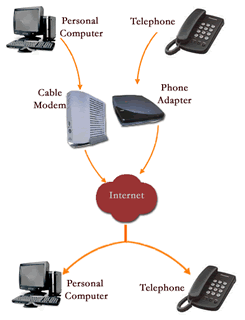 Internet telephony refers to communications services — voice, facsimile, and/or voice-messaging applications — that are transported via the Internet, rather than the public switched telephone network (PSTN). The basic steps involved in originating an Internet telephone call are conversion of the analog voice signal to digital format and compression/translation of the signal into Internet protocol (IP) packets for transmission over the Internet; the process is reversed at the receiving end. Voice over Internet Protocol (VoIP) is a general term for a family of transmission technologies for delivery of voice communications over IP networks such as the Internet or other packet-switched networks. Other terms frequently encountered and synonymous with VoIP are IP telephony, Internet telephony, voice over broadband (VoBB), broadband telephony and broadband phone.
Internet telephony refers to communications services — voice, facsimile, and/or voice-messaging applications — that are transported via the Internet, rather than the public switched telephone network (PSTN). The basic steps involved in originating an Internet telephone call are conversion of the analog voice signal to digital format and compression/translation of the signal into Internet protocol (IP) packets for transmission over the Internet; the process is reversed at the receiving end. Voice over Internet Protocol (VoIP) is a general term for a family of transmission technologies for delivery of voice communications over IP networks such as the Internet or other packet-switched networks. Other terms frequently encountered and synonymous with VoIP are IP telephony, Internet telephony, voice over broadband (VoBB), broadband telephony and broadband phone.

| A videoconference or video conference (also known as a videoteleconference) is a set of interactive telecommunication technologies which allow two or more locations to interact via two-way video and audio transmissions simultaneously. |
It has also been called 'visual collaboration ' and is a type of groupware. It differs from a videophone call in that it is designed to serve a conference rather than individuals.
File Transfer Protocol (FTP) is a standard network protocol used to exchange and manipulate files over a TCP/IP based network, such as the Internet. FTP is built on a client-server architecture and utilizes separate control and data connections between the client and server applications. Client applications were originally interactive command-line tools with a standardized command syntax, but graphical user interfaces have been developed for all desktop operating systems in use today. FTP is also often used as an application component to automatically transfer files for program internal functions.
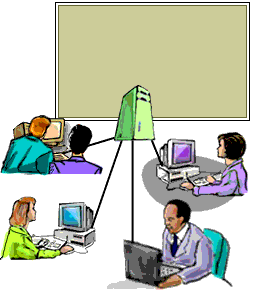
| A usenet newsgroup is a repository usually within the Usenet system, for messages posted from many users in different locations. The term may be confusing to some, because it is usually a discussion group. Newsgroups are technically distinct from, but functionally similar to, discussion forums on the World Wide Web. Newsreader software is used to read newsgroups. Newsgroups, where people send, read and respond to public bulletin board messages stored on a central computer. |
TELNET, a program that enables a computer to function as a terminal working from a remote computer and so use online databases or library catalogues.
|
|
|
|
|
Дата добавления: 2014-12-27; Просмотров: 1422; Нарушение авторских прав?; Мы поможем в написании вашей работы!